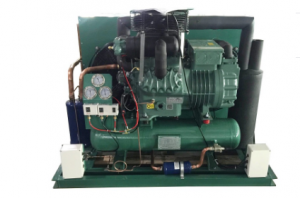ਦੋ-ਪੜਾਅ ਵਾਲਾ ਕੰਪ੍ਰੈਸਰ ਰੈਫ੍ਰਿਜਰੇਸ਼ਨ ਚੱਕਰ ਆਮ ਤੌਰ 'ਤੇ ਦੋ ਕੰਪ੍ਰੈਸਰਾਂ ਦੀ ਵਰਤੋਂ ਕਰਦਾ ਹੈ, ਅਰਥਾਤ ਇੱਕ ਘੱਟ-ਦਬਾਅ ਵਾਲਾ ਕੰਪ੍ਰੈਸਰ ਅਤੇ ਇੱਕ ਉੱਚ-ਦਬਾਅ ਵਾਲਾ ਕੰਪ੍ਰੈਸਰ।
1.1 ਰੈਫ੍ਰਿਜਰੈਂਟ ਗੈਸ ਦੇ ਵਾਸ਼ਪੀਕਰਨ ਦਬਾਅ ਤੋਂ ਸੰਘਣਾ ਦਬਾਅ ਤੱਕ ਵਧਣ ਦੀ ਪ੍ਰਕਿਰਿਆ ਨੂੰ 2 ਪੜਾਵਾਂ ਵਿੱਚ ਵੰਡਿਆ ਗਿਆ ਹੈ।
ਪਹਿਲਾ ਪੜਾਅ: ਘੱਟ-ਦਬਾਅ ਵਾਲੇ ਪੜਾਅ ਕੰਪ੍ਰੈਸਰ ਦੁਆਰਾ ਪਹਿਲਾਂ ਵਿਚਕਾਰਲੇ ਦਬਾਅ ਤੱਕ ਸੰਕੁਚਿਤ ਕੀਤਾ ਜਾਂਦਾ ਹੈ:
ਦੂਜਾ ਪੜਾਅ: ਵਿਚਕਾਰਲੇ ਦਬਾਅ ਹੇਠ ਗੈਸ ਨੂੰ ਵਿਚਕਾਰਲੇ ਕੂਲਿੰਗ ਤੋਂ ਬਾਅਦ ਉੱਚ-ਦਬਾਅ ਵਾਲੇ ਕੰਪ੍ਰੈਸਰ ਦੁਆਰਾ ਸੰਘਣਾਕਰਨ ਦਬਾਅ ਤੱਕ ਹੋਰ ਸੰਕੁਚਿਤ ਕੀਤਾ ਜਾਂਦਾ ਹੈ, ਅਤੇ ਰਿਸੀਪ੍ਰੋਕੇਟਿੰਗ ਚੱਕਰ ਇੱਕ ਰੈਫ੍ਰਿਜਰੇਸ਼ਨ ਪ੍ਰਕਿਰਿਆ ਨੂੰ ਪੂਰਾ ਕਰਦਾ ਹੈ।
ਘੱਟ ਤਾਪਮਾਨ ਪੈਦਾ ਕਰਦੇ ਸਮੇਂ, ਦੋ-ਪੜਾਅ ਵਾਲੇ ਕੰਪਰੈਸ਼ਨ ਰੈਫ੍ਰਿਜਰੇਸ਼ਨ ਚੱਕਰ ਦਾ ਇੰਟਰਕੂਲਰ ਉੱਚ-ਦਬਾਅ ਵਾਲੇ ਪੜਾਅ ਵਾਲੇ ਕੰਪ੍ਰੈਸਰ ਵਿੱਚ ਰੈਫ੍ਰਿਜਰੈਂਟ ਦੇ ਇਨਲੇਟ ਤਾਪਮਾਨ ਨੂੰ ਘਟਾਉਂਦਾ ਹੈ, ਅਤੇ ਉਸੇ ਕੰਪ੍ਰੈਸਰ ਦੇ ਡਿਸਚਾਰਜ ਤਾਪਮਾਨ ਨੂੰ ਵੀ ਘਟਾਉਂਦਾ ਹੈ।
ਕਿਉਂਕਿ ਦੋ-ਪੜਾਅ ਵਾਲਾ ਕੰਪਰੈਸ਼ਨ ਰੈਫ੍ਰਿਜਰੇਸ਼ਨ ਚੱਕਰ ਪੂਰੀ ਰੈਫ੍ਰਿਜਰੇਸ਼ਨ ਪ੍ਰਕਿਰਿਆ ਨੂੰ ਦੋ ਪੜਾਵਾਂ ਵਿੱਚ ਵੰਡਦਾ ਹੈ, ਇਸ ਲਈ ਹਰੇਕ ਪੜਾਅ ਦਾ ਕੰਪਰੈਸ਼ਨ ਅਨੁਪਾਤ ਸਿੰਗਲ-ਪੜਾਅ ਕੰਪਰੈਸ਼ਨ ਨਾਲੋਂ ਬਹੁਤ ਘੱਟ ਹੋਵੇਗਾ, ਜਿਸ ਨਾਲ ਉਪਕਰਣਾਂ ਦੀ ਤਾਕਤ ਲਈ ਲੋੜਾਂ ਘਟ ਜਾਣਗੀਆਂ ਅਤੇ ਰੈਫ੍ਰਿਜਰੇਸ਼ਨ ਚੱਕਰ ਦੀ ਕੁਸ਼ਲਤਾ ਵਿੱਚ ਬਹੁਤ ਸੁਧਾਰ ਹੋਵੇਗਾ। ਦੋ-ਪੜਾਅ ਵਾਲਾ ਕੰਪਰੈਸ਼ਨ ਰੈਫ੍ਰਿਜਰੇਸ਼ਨ ਚੱਕਰ ਵੱਖ-ਵੱਖ ਵਿਚਕਾਰਲੇ ਕੂਲਿੰਗ ਤਰੀਕਿਆਂ ਦੇ ਅਨੁਸਾਰ ਇੱਕ ਵਿਚਕਾਰਲੇ ਸੰਪੂਰਨ ਕੂਲਿੰਗ ਚੱਕਰ ਅਤੇ ਇੱਕ ਵਿਚਕਾਰਲੇ ਅਧੂਰੇ ਕੂਲਿੰਗ ਚੱਕਰ ਵਿੱਚ ਵੰਡਿਆ ਗਿਆ ਹੈ; ਜੇਕਰ ਇਹ ਥ੍ਰੋਟਲਿੰਗ ਵਿਧੀ 'ਤੇ ਅਧਾਰਤ ਹੈ, ਤਾਂ ਇਸਨੂੰ ਪਹਿਲੇ-ਪੜਾਅ ਦੇ ਥ੍ਰੋਟਲਿੰਗ ਚੱਕਰ ਅਤੇ ਦੂਜੇ-ਪੜਾਅ ਦੇ ਥ੍ਰੋਟਲਿੰਗ ਚੱਕਰ ਵਿੱਚ ਵੰਡਿਆ ਜਾ ਸਕਦਾ ਹੈ।

1.2 ਦੋ-ਪੜਾਅ ਵਾਲੇ ਕੰਪਰੈਸ਼ਨ ਰੈਫ੍ਰਿਜਰੈਂਟ ਕਿਸਮਾਂ
ਜ਼ਿਆਦਾਤਰ ਦੋ-ਪੜਾਅ ਵਾਲੇ ਕੰਪ੍ਰੈਸ਼ਨ ਰੈਫ੍ਰਿਜਰੇਸ਼ਨ ਸਿਸਟਮ ਦਰਮਿਆਨੇ ਅਤੇ ਘੱਟ ਤਾਪਮਾਨ ਵਾਲੇ ਰੈਫ੍ਰਿਜਰੇਸ਼ਨਾਂ ਦੀ ਚੋਣ ਕਰਦੇ ਹਨ। ਪ੍ਰਯੋਗਾਤਮਕ ਖੋਜ ਦਰਸਾਉਂਦੀ ਹੈ ਕਿ R448A ਅਤੇ R455a ਊਰਜਾ ਕੁਸ਼ਲਤਾ ਦੇ ਮਾਮਲੇ ਵਿੱਚ R404A ਲਈ ਚੰਗੇ ਬਦਲ ਹਨ। ਹਾਈਡ੍ਰੋਫਲੋਰੋਕਾਰਬਨ ਦੇ ਵਿਕਲਪਾਂ ਦੀ ਤੁਲਨਾ ਵਿੱਚ, CO2, ਇੱਕ ਵਾਤਾਵਰਣ ਅਨੁਕੂਲ ਕਾਰਜਸ਼ੀਲ ਤਰਲ ਦੇ ਰੂਪ ਵਿੱਚ, ਹਾਈਡ੍ਰੋਫਲੋਰੋਕਾਰਬਨ ਰੈਫ੍ਰਿਜਰੇਸ਼ਨਾਂ ਲਈ ਇੱਕ ਸੰਭਾਵੀ ਬਦਲ ਹੈ ਅਤੇ ਇਸ ਵਿੱਚ ਚੰਗੀਆਂ ਵਾਤਾਵਰਣ ਵਿਸ਼ੇਸ਼ਤਾਵਾਂ ਹਨ।
ਪਰ R134a ਨੂੰ CO2 ਨਾਲ ਬਦਲਣ ਨਾਲ ਸਿਸਟਮ ਦੀ ਕਾਰਗੁਜ਼ਾਰੀ ਵਿਗੜ ਜਾਵੇਗੀ, ਖਾਸ ਕਰਕੇ ਉੱਚ ਵਾਤਾਵਰਣ ਦੇ ਤਾਪਮਾਨਾਂ 'ਤੇ, CO2 ਸਿਸਟਮ ਦਾ ਦਬਾਅ ਕਾਫ਼ੀ ਜ਼ਿਆਦਾ ਹੁੰਦਾ ਹੈ ਅਤੇ ਮੁੱਖ ਹਿੱਸਿਆਂ, ਖਾਸ ਕਰਕੇ ਕੰਪ੍ਰੈਸਰ ਦੇ ਵਿਸ਼ੇਸ਼ ਇਲਾਜ ਦੀ ਲੋੜ ਹੁੰਦੀ ਹੈ।
1.3 ਦੋ-ਪੜਾਅ ਵਾਲੇ ਕੰਪਰੈਸ਼ਨ ਰੈਫ੍ਰਿਜਰੇਸ਼ਨ 'ਤੇ ਅਨੁਕੂਲਨ ਖੋਜ
ਵਰਤਮਾਨ ਵਿੱਚ, ਦੋ-ਪੜਾਅ ਵਾਲੇ ਕੰਪਰੈਸ਼ਨ ਰੈਫ੍ਰਿਜਰੇਸ਼ਨ ਚੱਕਰ ਪ੍ਰਣਾਲੀ ਦੇ ਅਨੁਕੂਲਨ ਖੋਜ ਨਤੀਜੇ ਮੁੱਖ ਤੌਰ 'ਤੇ ਹੇਠ ਲਿਖੇ ਅਨੁਸਾਰ ਹਨ:
(1) ਇੰਟਰਕੂਲਰ ਵਿੱਚ ਟਿਊਬ ਕਤਾਰਾਂ ਦੀ ਗਿਣਤੀ ਵਧਾਉਂਦੇ ਹੋਏ, ਏਅਰ ਕੂਲਰ ਵਿੱਚ ਟਿਊਬ ਕਤਾਰਾਂ ਦੀ ਗਿਣਤੀ ਘਟਾਉਣ ਨਾਲ ਇੰਟਰਕੂਲਰ ਦੇ ਗਰਮੀ ਐਕਸਚੇਂਜ ਖੇਤਰ ਨੂੰ ਵਧਾਇਆ ਜਾ ਸਕਦਾ ਹੈ ਜਦੋਂ ਕਿ ਏਅਰ ਕੂਲਰ ਵਿੱਚ ਟਿਊਬ ਕਤਾਰਾਂ ਦੀ ਵੱਡੀ ਗਿਣਤੀ ਕਾਰਨ ਹੋਣ ਵਾਲੇ ਹਵਾ ਦੇ ਪ੍ਰਵਾਹ ਨੂੰ ਘਟਾਇਆ ਜਾ ਸਕਦਾ ਹੈ। ਇਸਦੇ ਇਨਲੇਟ ਤੇ ਵਾਪਸ ਆਉਂਦੇ ਹੋਏ, ਉਪਰੋਕਤ ਸੁਧਾਰਾਂ ਦੁਆਰਾ, ਇੰਟਰਕੂਲਰ ਦੇ ਇਨਲੇਟ ਤਾਪਮਾਨ ਨੂੰ ਲਗਭਗ 2°C ਤੱਕ ਘਟਾਇਆ ਜਾ ਸਕਦਾ ਹੈ, ਅਤੇ ਉਸੇ ਸਮੇਂ, ਏਅਰ ਕੂਲਰ ਦੇ ਕੂਲਿੰਗ ਪ੍ਰਭਾਵ ਦੀ ਗਰੰਟੀ ਦਿੱਤੀ ਜਾ ਸਕਦੀ ਹੈ।
(2) ਘੱਟ-ਦਬਾਅ ਵਾਲੇ ਕੰਪ੍ਰੈਸਰ ਦੀ ਬਾਰੰਬਾਰਤਾ ਨੂੰ ਸਥਿਰ ਰੱਖੋ, ਅਤੇ ਉੱਚ-ਦਬਾਅ ਵਾਲੇ ਕੰਪ੍ਰੈਸਰ ਦੀ ਬਾਰੰਬਾਰਤਾ ਨੂੰ ਬਦਲੋ, ਜਿਸ ਨਾਲ ਉੱਚ-ਦਬਾਅ ਵਾਲੇ ਕੰਪ੍ਰੈਸਰ ਦੀ ਗੈਸ ਡਿਲੀਵਰੀ ਵਾਲੀਅਮ ਦਾ ਅਨੁਪਾਤ ਬਦਲਦਾ ਹੈ। ਜਦੋਂ ਵਾਸ਼ਪੀਕਰਨ ਦਾ ਤਾਪਮਾਨ -20°C 'ਤੇ ਸਥਿਰ ਹੁੰਦਾ ਹੈ, ਤਾਂ ਵੱਧ ਤੋਂ ਵੱਧ COP 3.374 ਹੁੰਦਾ ਹੈ, ਅਤੇ ਵੱਧ ਤੋਂ ਵੱਧ COP ਦੇ ਅਨੁਸਾਰੀ ਗੈਸ ਡਿਲੀਵਰੀ ਅਨੁਪਾਤ 1.819 ਹੁੰਦਾ ਹੈ।
(3) ਕਈ ਆਮ CO2 ਟ੍ਰਾਂਸਕ੍ਰਿਟੀਕਲ ਦੋ-ਪੜਾਅ ਕੰਪਰੈਸ਼ਨ ਰੈਫ੍ਰਿਜਰੇਸ਼ਨ ਸਿਸਟਮਾਂ ਦੀ ਤੁਲਨਾ ਕਰਕੇ, ਇਹ ਸਿੱਟਾ ਕੱਢਿਆ ਜਾਂਦਾ ਹੈ ਕਿ ਗੈਸ ਕੂਲਰ ਦਾ ਆਊਟਲੈੱਟ ਤਾਪਮਾਨ ਅਤੇ ਘੱਟ-ਦਬਾਅ ਵਾਲੇ ਪੜਾਅ ਕੰਪ੍ਰੈਸਰ ਦੀ ਕੁਸ਼ਲਤਾ ਇੱਕ ਦਿੱਤੇ ਦਬਾਅ 'ਤੇ ਚੱਕਰ 'ਤੇ ਬਹੁਤ ਪ੍ਰਭਾਵ ਪਾਉਂਦੀ ਹੈ, ਇਸ ਲਈ ਜੇਕਰ ਤੁਸੀਂ ਸਿਸਟਮ ਕੁਸ਼ਲਤਾ ਨੂੰ ਬਿਹਤਰ ਬਣਾਉਣ ਲਈ ਚਾਹੁੰਦੇ ਹੋ, ਤਾਂ ਗੈਸ ਕੂਲਰ ਦੇ ਆਊਟਲੈੱਟ ਤਾਪਮਾਨ ਨੂੰ ਘਟਾਉਣਾ ਅਤੇ ਉੱਚ ਸੰਚਾਲਨ ਕੁਸ਼ਲਤਾ ਵਾਲਾ ਘੱਟ-ਦਬਾਅ ਵਾਲਾ ਪੜਾਅ ਕੰਪ੍ਰੈਸਰ ਚੁਣਨਾ ਜ਼ਰੂਰੀ ਹੈ।
ਪੋਸਟ ਸਮਾਂ: ਮਾਰਚ-22-2023





